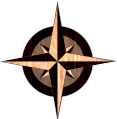. . .On the 10th at 5 in the morning, we left the moorings and started out of the harbour, and as the weather was fine, I enjoyed the beautiful sight of the shore from Copenhagen to Elsinore with the Kronborg Castle and the Marienlyst Palace, and rather expecting it to be the last time, I felt sober but pleased.[p.191]
One of the cabin passengers was an English lady whose husband was a mercantile agent. She had been married awhile and had no hope of having children, and she desired me to let her have the child. This, of course, I could no do and I told her that I should not think it would be much of a matter for her to obtain such a child either in Hull or in Copenhagen as there, sorry to say, were many of them. "Yes," said she, "that's true, but it's a rare thing to see so pretty a one."
We arrived in Hull (Kingston upon Hull) on the 13th about 3 in the afternoon.
When our luggage was being taken out of the hull, I found that my chest was missing. I felt grieved about it, but I concluded that it was left in the steamer from Aalborg, for I had charged Brother Nielsen to see that all the luggage was taken ashore while I went to our office to report our arrival, but when everybody had got their own things ashore, no one thought of mine being left, and as he never had been in the big city before, I must excuse him being a little childishly excited. Brother Flygare, the president of the mission was along and promised to send me my chest in safe hands.
At 7 in the evening we left Hull and arrived in Liverpool at 2 in the morning of the 14th. At 4 in the morning of the 15th, we left the dock and at 11 we started and came to Queenstown at 6 the next morning. We laid there one hour and at 3 in the afternoon we lost sight of Ireland and I felt to say "Farewell Europe."
Arrangement was made so that a number of us returning missionaries had cabin fares. We had the pleasure of having Elder Joseph F. Smith with us.
I wrote in my journal on the 20th, that I had not had time to write and that day at noon, we were already half way to New York. The ship rolled much and the wind was blowing high.
On the 23rd, I wrote. "Yesterday something broke about the pump and we had to lay still for several hours while we saw several schooners. Another steamship passed us."
I was very busy all the time. On the 21st we saw an iceberg about two miles off.
On the 25th, it says. "Pilot onbound." On the 26th, "This morning at 3 o'clock we anchored in the river and in the afternoon we laid into the pier and expect to go ashore tomorrow morning." One U.S. and one French frigate are lying at anchor nearby, a beautiful sight to me.
Next morning we moved from shipboard into the old castle building, which is used for the accommodation of emigrants. (*Ellis Island, New York Harbor) The name of the steamship we came in was Wyoming. I was told that it was 300 feet long and it had 4 decks. My state room was over the screw, but I soon got used to the noise. The vessel being so long made it so much better for the passengers, and I liked to stand in one end and look along the deck and see it gallop over the great billows. In the evening, we started for the railroad.
On the 28th, we passed over the Allegheny Mountains which was a very rough region.
On the 29th, while at Bradford, Ohio, Peter Bow's grandchild died and was left to be buried, and in the afternoon, we passed over the Ohio River on a bridge to Logan for Logansburgh. The town was mostly frame houses. That day we passed over level land, but only half cultivated. Much forest, but no large trees.
On the 30th, we passed through Peoria before day and about midday we crossed the Mississippi to Burlington, where we changed cars and had to wait while a steamboat passed through the bridge.
On the 1st Oct., we changed cars at Council Bluffs and crossed over to Omaha. That evening after dark, President U.S. Grant passed us on his way to California.
On the 2nd we cross North Platte, and on the morning of the 3rd, we passed Cheyenne and about the middle of the day [p. 192] we passed through the Black Hills with two engines. The largest was said to be the largest ever built and that it weighed 54 tons.
On the 5th we arrived in Ogden. I cannot understand what little I did note in my daybook and I do not recollect whether we were taken to Salt Lake City the same day or not, but any rate I had to return to Ogden on account of my luggage which was left behind, and on the 6th, I think, I met my son, Heber, as also his mother. [p. 193]
BIB: Hansen, Peter Olsen, An Autobiography of Peter Olsen Hansen, 1818-1895, comp. by Leland Hansen Ashby (2nd Printing, 1988) pp. 192-93. (CHL)
(source abbreviations)
 Saints by Sea
Saints by Sea